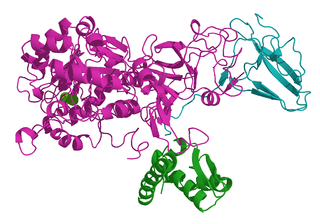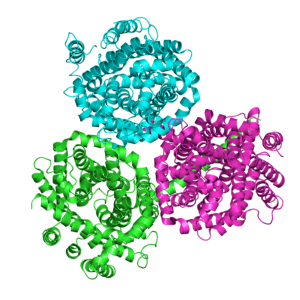
Ureases, functionally, belong to the superfamily of amidohydrolases and phosphotriesterases. Ureases are found in numerous bacteria, fungi, algae, plants, and some invertebrates, as well as in soils, as a soil enzyme. They are nickel-containing metalloenzymes of high molecular weight.
The sodium/phosphate cotransporter is a member of the phosphate:Na+ symporter (PNaS) family within the TOG Superfamily of transport proteins as specified in the Transporter Classification Database (TCDB).

Pre-B-cell leukemia transcription factor 1 is a protein that in humans is encoded by the PBX1 gene.
In enzymology, a nickel-transporting ATPase (EC 3.6.3.24) is an enzyme that catalyzes the chemical reaction

Histidine kinases (HK) are multifunctional, and in non-animal kingdoms, typically transmembrane, proteins of the transferase class of enzymes that play a role in signal transduction across the cellular membrane. The vast majority of HKs are homodimers that exhibit autokinase, phosphotransfer, and phosphatase activity. HKs can act as cellular receptors for signaling molecules in a way analogous to tyrosine kinase receptors (RTK). Multifunctional receptor molecules such as HKs and RTKs typically have portions on the outside of the cell that bind to hormone- or growth factor-like molecules, portions that span the cell membrane, and portions within the cell that contain the enzymatic activity. In addition to kinase activity, the intracellular domains typically have regions that bind to a secondary effector molecule or complex of molecules that further propagate signal transduction within the cell. Distinct from other classes of protein kinases, HKs are usually parts of a two-component signal transduction mechanisms in which HK transfers a phosphate group from ATP to a histidine residue within the kinase, and then to an aspartate residue on the receiver domain of a response regulator protein. More recently, the widespread existence of protein histidine phosphorylation distinct from that of two-component histidine kinases has been recognised in human cells. In marked contrast to Ser, Thr and Tyr phosphorylation, the analysis of phosphorylated Histidine using standard biochemical and mass spectrometric approaches is much more challenging, and special procedures and separation techniques are required for their preservation alongside classical Ser, Thr and Tyr phosphorylation on proteins isolated from human cells.
ABC transporter transmembrane domain is the main transmembrane structural unit of ATP-binding cassette transporter proteins, consisting of six alpha helixes that traverse the plasma membrane. Many members of the ABC transporter family have two such regions.

Proteins of the Betaine/Carnitine/Choline Transporter (BCCT) family are found in Gram-negative and Gram-positive bacteria and archaea. The BCCT family is a member a large group of secondary transporters, the APC superfamily. Their common functional feature is that they all transport molecules with a quaternary ammonium group [R-N (CH3)3]. The BCCT family proteins vary in length between 481 and 706 amino acyl residues and possess 12 putative transmembrane α-helical spanners (TMSs). The x-ray structures reveal two 5 TMS repeats with the total number of TMSs being 10. These porters catalyze bidirectional uniport or are energized by pmf-driven or smf-driven proton or sodium ion symport, respectively, or else by substrate:substrate antiport. Some of these permeases exhibit osmosensory and osmoregulatory properties inherent to their polypeptide chains.
The Nucleobase:Cation Symporter-2(NCS2) Family, also called the Nucleobase/Ascorbate Transporter(NAT) Family, consists of over 1000 sequenced proteins derived from gram-negative and gram-positive bacteria, archaea, fungi, plants and animals. The NCS2/NAT family is a member of the APC Superfamily of secondary carriers. Of the five known families of transporters that act on nucleobases, NCS2/NAT is the only one that is most widespread. Many functionally characterized members are specific for nucleobases including both purines and pyrimidines, but others are purine-specific. However, two closely related rat/human members of the family, SVCT1 and SVCT2, localized to different tissues of the body, co-transport L-ascorbate (vitamin C) and Na+ with a high degree of specificity and high affinity for the vitamin. Clustering of NCS2/NAT family members on the phylogenetic tree is complex, with bacterial proteins and eukaryotic proteins each falling into at least three distinct clusters. The plant and animal proteins cluster loosely together, but the fungal proteins branch from one of the three bacterial clusters forming a tighter grouping. E. coli possesses four distantly related paralogous members of the NCS2 family.
Cation diffusion facilitators (CDFs) are transmembrane proteins that provide tolerance of cells to divalent metal ions, such as cadmium, zinc, and cobalt. These proteins are considered to be efflux pumps that remove these divalent metal ions from cells. However, some members of the CDF superfamily are implicated in ion uptake. All members of the CDF family possess six putative transmembrane spanners with strongest conservation in the four N-terminal spanners. The Cation Diffusion Facilitator (CDF) Superfamily includes the following families:

The mercury transporter superfamily is a family of transmembrane bacterial transporters of mercury ions. The common origin of all Mer superfamily members has been established. The common elements between family members are included in TMSs 1-2. A representative list of the subfamilies and proteins that belong to those subfamilies is available in the Transporter Classification Database.

In molecular biology, ZinT is a family of protein domains found in prokaryotes. The domain contains a single binding site that can accommodate a divalent cation, with a geometry suggestive of zinc binding. This family was first thought to be part of the bacterial response to a toxic heavy metal cadmium by binding to the metal to ensure its elimination; however, more recent work has suggested a role in zinc homeostasis.
The nik operon is an operon required for uptake of nickel ions into the cell. It is present in many bacteria, but has been extensively studied in Helicobacter pylori. Nickel is an essential nutrient for many microorganisms, where it participates in a variety of cellular processes. However, excessive levels of nickel ions in cell can be fatal to the cell. Nickel ion concentration in the cell is regulated through the nik operon.
The transporter-opsin-G protein-coupled receptor (TOG) superfamily is a protein superfamily of integral membrane proteins, usually of 7 or 8 transmembrane alpha-helical segments (TMSs). It includes (1) ion-translocating microbial rhodopsins and (2) G protein-coupled receptors (GPCRs), (3) Sweet sugar transporters, (4) nicotinamide ribonucleoside uptake permeases (PnuC; TC# 4.B.1), (5) 4-toluene sulfonate uptake permeases (TSUP); TC# 2.A.102), (6) Ni2+–Co2+ transporters (NiCoT); TC# 2.A.52), (7) organic solute transporters (OST); TC# 2.A.82), (8) phosphate:Na+ symporters (PNaS); TC# 2.A.58) and (9) lysosomal cystine transporters (LCT); TC# 2.A.43).
The Nicotinamide Ribonucleoside (NR) Uptake Permease (PnuC) Family is a family of transmembrane transporters that is part of the TOG superfamily. Close PnuC homologues are found in a wide range of Gram-negative and Gram-positive bacteria, archaea and eukaryotes.
The iron/lead transporter (ILT) family is a family of transmembrane proteins within the lysine exporter (LysE) superfamily. The ILT family includes two subfamilies, the iron-transporting (OFeT) family and the lead-transporting (PbrT) family. A representative list of the proteins belonging to these subfamilies of the ILT family can be found in the Transporter Classification Database.
The Nickel/Cobalt Transporter (NicO) Family is a member of the Lysine Exporter (LysE) Superfamily. A representative list of proteins belonging to the NicO family can be found in the Transporter Classification Database.
The Citrate-Mg2+:H+ (CitM) / Citrate-Ca2+:H+ (CitH) Symporter (CitMHS) Family (TC# 2.A.11) is a family of transport proteins belonging to the Ion transporter superfamily. Members of this family are found in Gram-positive and Gram-negative bacteria, archaea and possibly eukaryotes. These proteins all probably arose by an internal gene duplication event. Lensbouer & Doyle (2010) have reviewed these systems, classifying the porters with three superfamilies, according to ion-preference:

Resistance-nodulation-division (RND) family transporters are a category of bacterial efflux pumps, especially identified in Gram-negative bacteria and located in the cytoplasmic membrane, that actively transport substrates. The RND superfamily includes seven families: the heavy metal efflux (HME), the hydrophobe/amphiphile efflux-1, the nodulation factor exporter family (NFE), the SecDF protein-secretion accessory protein family, the hydrophobe/amphiphile efflux-2 family, the eukaryotic sterol homeostasis family, and the hydrophobe/amphiphile efflux-3 family. These RND systems are involved in maintaining homeostasis of the cell, removal of toxic compounds, and export of virulence determinants. They have a broad substrate spectrum and can lead to the diminished activity of unrelated drug classes if over-expressed. The first reports of drug resistant bacterial infections were reported in the 1940s after the first mass production of antibiotics. Most of the RND superfamily transport systems are made of large polypeptide chains. RND proteins exist primarily in gram-negative bacteria but can also be found in gram-positive bacteria, archaea, and eukaryotes.
The PTS L-Ascorbate (L-Asc) Family includes porters specific for L-ascorbate, and is part of the PTS-AG superfamily. A single PTS permease of the L-Asc family of PTS permeases has been functionally characterized. This is the SgaTBA system, renamed UlaABC by Yew and Gerlt.











